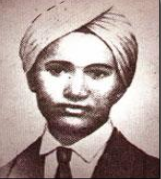Kartar Singh Sarabha Grewal (1896-1915), a great Ghadar revolutionary leader was born into a Grewal Jat Sikh family at village Sarabha of District Ludhiana, Punjab. His father's name was Sardar Mangal Singh, a well-to-do farmer. After receiving his primary education in his village school, Kartar Singh entered the Malwa Khalsa High school at Ludhiana for his matriculation. He was in tenth class when he went to live with his uncle in Orissa where, after finishing high school, he joined college. When he was barely sixteen, his parents put him on board a ship for America for further study and work. The ship landed at the American port of San Francisco in January 1912. The American Immigration officer put Indians through rigorous questioning while people of other countries were allowed to pass after slight checks. Kartar Singh asked one of the passengers about this type of behaviour. He told him, "Indians are the citizens of a slave country. As such, they are treated badly."
This incident had a great effect on Sarabha. In 1914, Indians worked in foreign countries either as indentured labourers or soldiers fighting for the consolidation of British rule or extending the boundaries of the British Empire. Kartar enrolled at the University of California at Berkeley (UCB) enrolling for a degree in chemistry. He also took up the work of picking fruit in orchards. His association with Nalanda club of Indian students at Berkeley aroused his patriotic sentiments and he felt agitated about the treatment immigrants from India, especially manual workers received in the United States. He frequently talked to other Indians about getting his country freed.
On April 21, 1913, the Indians of California assembled and formed the Ghadar Party (Revolution Party) with Sohan Singh, a Sikh farmer from Bhakna village in Amritsar district, as president and Lala Hardyal as secretary. Kartar Singh stopped his university work and moved in with Hardyal. The aim of the Ghadar Party was to get rid of the slavery of the British by means of an armed struggle and set up a national democratic government. Their slogan was "Put at stake everything for the freedom of the country." On the November 1, 1913, the Ghadar Party started printing a paper named Ghadar, which was published in the Punjabi, Hindi, Urdu, Bengali, Gujarati and Pushto languages. This paper was sent to Indians living in all countries throughout the world. The purpose of the paper was to unmask the truth about British rule to Indians, impart military training, and explain in details the methods of making and using weapons and explosives.
Within a short time, the Ghadar Party became very famous through its organ: 'The Ghadar". It drew Indians from all walks of life. Kartar Singh started assisting in running the revolutionary newspaper Ghadar ("Revolt") and did all the work for that paper.He undertook the responsibility for printing of the Gurmukhi edition of the paper. He composed patriotic poetry for it and wrote articles. He also went out among the Sikh farmers and arranged meetings at which he and other Ghadar leaders made speeches urging them to initiate united action against British. At a meeting at Sacramento, California, on 31 October 1913, he jumped to the stage and began to sing: "Chalo chaliye des nu Yuddha karne, eho aakhiri vachan farman hoye!" (Come! let us go and join the battle of freedom; the final call has come, let us go!)
With the start of World War I in 1914, the British became thoroughly engrossed in the war effort. Thinking it to be a good opportunity, the leaders of the Ghadar Party published the "Decision of Declaration of War" against the British in issue of 'The Ghadar' dated August 5, 1914. Thousands of copies of the paper were distributed among army cantonments, villages and cities. Kartar Singh reached Calcutta via Colombo on board SS Salamin in November 1914: he accompanied two other Gadhar leaders, Satyen Sen and Vishnu Ganesh Pingle, along with a large number of Gadhar freedom fighters. With a letter of introduction from Jatin Mukherjee, the Jugantar leader, Kartar Singh and Pingle met Rash Behari Bose at Benares to inform him that twenty thousand more Gadhar members were expected very soon.[1] A large number of leaders of the Ghadar Party were arrested by the Government at the ports. In spite of these arrests, a meeting was held by members of the Ghadar Party at Ladhouwal near Ludhiana in which it was decided to commit robberies in the houses of the rich to meet requirements of finance for armed action. Two Ghadris, Waryam Singh and Bhai Ram Rakha were killed in a bomb blast in one such raid.
After the arrival of Rash Behari Bose at Amritsar on January 25, 1915, it was decided on a meeting on February 12 that the uprising should be started on February 21. It was planned that after capturing the cantonments of Mian Mir and Ferozepur, mutiny was to be engineered near Ambala and Delhi.
As World War I broke out, members of Ghadar party were openly exhorted to return to India to start armed revolt against the British. Kartar Singh left the United States on 15 September 1914, nearly a month ahead of the main body of Sikhs who were to follow. He returned to India via Colombo, resolved to set up in his village a centre on the model of Ghadr party's Yugantar Ashram in San Francisco. When Bhai Parmanand arrived in India in December 1914 to lead the movement, Kartar Singh was charged with spreading the network in Ludhiana district. In this connection, he went to Bengal to secure weapons, and made contacts with revolutionaries such as Vishnu Ganesh Pingley, Sachindra Nath Sanyal and Rash Bihari Bose. With Pingley, Kartar Singh visited cantonments at Meerut, Agra, Benaras, Allahabad, Ambala, Lahore and Rawalpindi, with a view to inciting soldiers to revolt. For armaments, Kartar Singh and his associates succeeded in manufacturing bombs on a small scale at Jhabewal and later at Lohtbaddi, both in Ludhiana district. Kartar Singh organized and participated in raids on the villages of Sahnewal and Mansuran in January 1915, in order to procure funds for the party.
In February 1915, just before the planned revolt was to erupt, there was a massive roundup of the Ghadar leaders, Kirpal Singh, a police informer ('mole') in the ranks of the Ghadar Party had a large number of members arrested on February 19 and informed the Government of the planned revolt. The Government disarmed the native soldiers due to which the revolt failed. Kartar Singh, Jagat Singh of Sursingh, and Harnam Singh Tundilat escaped to Kabul. All three however came back to Punjab to continue their work. On March 2, 1915, Risaldar Ganda Singh had Kartar Singh, Harman Singh, Tundilat, and Jagit Singh, arrested from Chakk, No. 5, district Lyallpur at Wilsonpur, in Shahpur district, where they had gone to incite the troops of the 22nd Cavalry.
The trial of arrested leaders in the Lahore conspiracy cases of 1915-1916 highlighted the role of Kartar Singh Sarabha in the movement. He soon became the symbol of martyrdom and many were influenced from his bravery and sacrifice. Bhagat Singh, another great revolutionary of Indian freedom, regarded Kartar Singh as his guru, friend and brother.
His defence consisted of just one eloquent statement of his revolutionary creed. The judgment in respect of 63 arrested Gadharites was pronounced on September 13, 1915, at the Central Jail, Lahore. In this first conspiracy case of 1914/15 AD, 24 Gadarites were sentenced to death. The judges during his trial were impressed by his intellectual skills, but nonetheless he was sentenced to death by hanging. The court observed that Kartar Singh was the most dangerous of all the rebels. "He is very proud of the crimes committed by him. He does not deserve mercy and should be sentenced to death". He was sentenced to death at Lahore, on 13 September 1915. Kartar Singh was hanged in the Central Jail of Lahore on November 16, 1915, when he was only 18. He kissed the hangman's noose with his favorite patriotic song on his lips and he died singing:
"Sewa desh di jinddhiye badhi aukhi, gallan karnia dher sukhalliyan ne,
jinha desh sewa 'ch pair paya, ohna lakh museebtan jhalliyan ne."
(Serving ones country is very difficult, It is so easy to talk
Anyone who walked on that path,Must endure millions of calamities.)
A statue of Kartar Singh, erected in the city of Ludhiana commemorates his legendary heroism. He has also been immortalized in the fictional account Ikk Myan Do Talwaran by famous Punjabi novelist, Nanak Singh. A statue of him was erected in Ludhiana, and Punjabi novelist Nanak Singh wrote a novel called Ikk Mian Do Talwaran based on his life.
Bibliography
1. Harbans Singh, The encyclopedia of Sikhism, Punjabi University, Patiala.
2. "http://www.sikhiwiki.org/index.php/Kartar_Singh_Sarabha"







